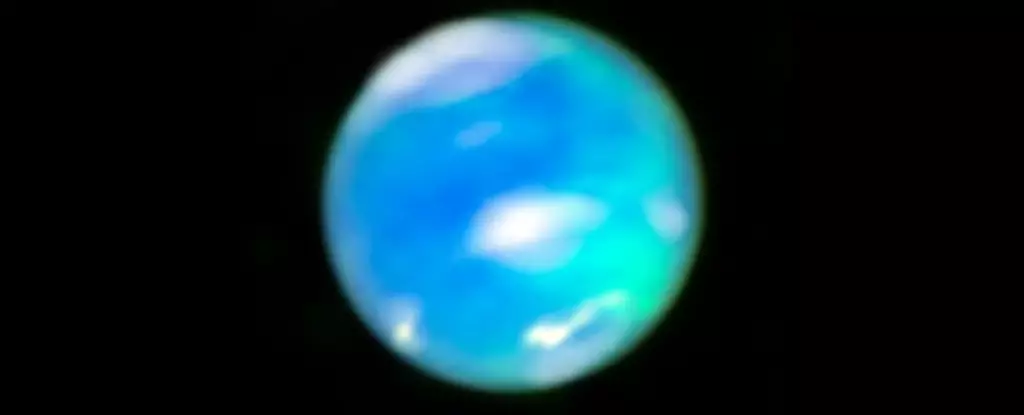The universe is full of mysteries, but few phenomena intrigue astronomers as much as the enchanting auroras that grace the atmospheres of planets across the Solar System. Recently, the James Webb Space Telescope (JWST) has successfully pierced through the enigma surrounding Neptune, the most distant planet in our solar neighborhood. For the first time, we have vivid, near-infrared images showcasing the planet’s ethereal auroras, adding an exciting chapter to our understanding of planetary atmospheres and their interactions with solar winds. But why does this matter?
The implication extends beyond just the thrill of seeing a new celestial happening; it represents a significant step in our understanding of how solar winds engage with different planetary environments. Neptune’s auroras are not merely celestial decorations but crucial indicators of the atmospheric and magnetic interactions that govern its climate and composition.
The Science Behind the Beauty
Neptune’s auroras have long eluded scientists, sparking debates over whether they even existed due to the planet’s distance from the Sun—approximately 30 times farther than Earth. Previous attempts to detect these atmospheric lights were hampered by inaccurate temperature measurements, which led to incorrect assumptions regarding auroral activity. However, the latest findings from JWST revealed a crucial factor: the presence of the trihydrogen cation (H3+), an essential ingredient in understanding auroral activities.
By employing a powerful near-infrared spectrometer, researchers led by astronomer Henrik Melin were able to map Neptune’s auroras precisely. The important shift in focus from pole-centered to equatorial auroras presents a conceptual leap in our grasp of planetary magnetism. Unlike Earth, where auroras predominantly occur near the poles because of the magnetic field configuration, Neptune’s magnetosphere reveals a chaotic, lopsided structure that channels solar energy to its equator.
This revelation challenges our conventional understanding of atmospheric science and magnetic fields and generates crucial questions about how different types of solar interactions influence planetary atmospheres. Neptune’s unique auroras may hold the key to anticipating atmospheric phenomena on distant exoplanets, especially those orbiting in their stars’ habitable zones.
A Broader Universe of Auroras
What’s captivating about Neptune’s newly observed auroras is how they fit into a broader narrative of auroral phenomena throughout our Solar System. Each planet exhibits auroras in distinct forms, reflecting a variety of atmospheric conditions and magnetic interactions. Jupiter boasts the most energetic auroras, punctuated by permanent ultraviolet light capes. On Saturn, ultraviolet auroras grace its gaseous envelope in stunning displays. Even our neighboring planets—Mars and Venus—display their own unique auroral characteristics, from Martian dust storms interacting with solar winds to Venus’ spectacular green lights.
Contrarily, Mercury, with its lack of atmosphere, exhibits auroras as X-ray fluorescence as solar particles collide with surface minerals. Each of these planetary differences underscores an underlying cosmic truth: auroras are not merely a byproduct of solar wind and atmospheric interaction but also offer insights into magnetic fields, elemental compositions, and long-term climatic conditions across celestial bodies.
The Path Ahead: A Quest for Cosmic Understanding
As we stand on the precipice of a new era in space exploration, the full implications of these recent discoveries at Neptune extend far beyond the icy confines of our Solar System. The data gleaned from the JWST opens doors to studying exoplanets orbiting distant stars, where future missions could seek out similar auroral features. Understanding how these phenomena manifest in different environments would allow us to predict atmospheric behavior in alien ecosystems, heightening the prospects for detecting habitable zones beyond our earthly realm.
The tantalizing exploration of Neptune’s auroras also serves as a reminder that our understanding of the universe is still in its infancy. Even as we marvel at our capabilities to observe distant worlds, there remain vast expanses of knowledge yet to be uncovered. Each discovery challenges our perceptions, ignites curiosity, and invites further inquiry. Whether through future observations or ongoing theoretical research, the pursuit of cosmic knowledge will forever be intertwined with the brilliant, shimmering lights of auroras that dance across the celestial tapestry.


Leave a Reply